The Facile Deposition of Pt Nanoparticles on Reduced Graphite Oxide in Tunable Aryl Alkyl Ionic Liquids for ORR Catalysts
Abstract
:1. Introduction
2. Results
2.1. rGO and TAAIL Presentation
2.2. Pt-NP Synthesis and Characterization
2.3. Pt-NPs Aggregation in TAAILs
2.4. Electrochemical Catalysis
2.5. Stability Testing
3. Conclusions
4. Materials and Methods
4.1. Chemicals and Equipment
4.2. Synthesis of Pt-NPs in IL
4.3. Electrochemical Measurements
Supplementary Materials
Author Contributions
Funding
Institutional Review Board Statement
Informed Consent Statement
Data Availability Statement
Acknowledgments
Conflicts of Interest
References
- Li, M.; Zhao, Z.; Cheng, T.; Fortunelli, A.; Chen, C.-Y.; Yu, R.; Zhang, Q.; Gu, L.; Merinov, B.; Lin, Z.; et al. Ultrafine jagged platinum nanowires enable ultrahigh mass activity for the oxygen reduction reaction. Science 2016, 354, 1414–1419. [Google Scholar] [CrossRef] [PubMed] [Green Version]
- Mahata, A.; Nair, A.S.; Pathak, B. Recent advancements in Pt-nanostructure-based electrocatalysts for the oxygen reduction reaction. Catal. Sci. Technol. 2019, 9, 4835–4863. [Google Scholar] [CrossRef]
- Lai, J.; Guo, S. Design of Ultrathin Pt-Based Multimetallic Nanostructures for Efficient Oxygen Reduction Electrocatalysis. Small 2017, 13, 1702156. [Google Scholar] [CrossRef] [PubMed]
- Calderón, J.C.; Ndzuzo, L.; Bladergroen, B.J.; Pasupathi, S. Catalytic activity of carbon supported-Pt-Pd nanoparticles toward the oxygen reduction reaction. Mater. Today Proc. 2018, 5, 10551–10560. [Google Scholar] [CrossRef]
- Shao, M.; Chang, Q.; Dodelet, J.-P.; Chenitz, R. Recent Advances in Electrocatalysts for Oxygen Reduction Reaction. Chem. Rev. 2016, 116, 3594–3657. [Google Scholar] [CrossRef] [Green Version]
- Bao, J.; Wang, J.; Zhou, Y.; Hu, Y.; Zhang, Z.; Li, T.; Xue, Y.; Guo, C.; Zhang, Y. Anchoring ultrafine PtNi nanoparticles on N-doped graphene for highly efficient hydrogen evolution reaction. Catal. Sci. Technol. 2019, 9, 4961–4969. [Google Scholar] [CrossRef]
- Chen, H.; Wang, G.; Gao, T.; Chen, Y.; Liao, H.; Guo, X.; Li, H.; Liu, R.; Dou, M.; Nan, S.; et al. Effect of Atomic Ordering Transformation of PtNi Nanoparticles on Alkaline Hydrogen Evolution: Unexpected Superior Activity of the Disordered Phase. J. Phys. Chem. C 2020, 124, 5036–5045. [Google Scholar] [CrossRef]
- Zhang, H.; Bo, X.; Guo, L. Electrochemical preparation of Pt nanoparticles supported on porous graphene with ionic liquids: Electrocatalyst for both methanol oxidation and H2O2 reduction. Electrochim. Acta 2016, 201, 117–124. [Google Scholar] [CrossRef]
- Cao, Y.; Yang, Y.; Shan, Y.; Huang, Z. One-Pot and Facile Fabrication of Hierarchical Branched Pt-Cu Nanoparticles as Excellent Electrocatalysts for Direct Methanol Fuel Cells. ACS Appl. Mater. Interfaces 2016, 8, 5998–6003. [Google Scholar] [CrossRef]
- Ouyang, Y.; Cao, H.; Wu, H.; Wu, D.; Wang, F.; Fan, X.; Yuan, W.; He, M.; Zhang, L.Y.; Li, C.M. Tuning Pt-skinned PtAg nanotubes in nanoscales to efficiently modify electronic structure for boosting performance of methanol electrooxidation. Appl. Catal. B Environ. 2020, 265, 118606. [Google Scholar] [CrossRef]
- Xie, C.; Niu, Z.; Kim, D.; Li, M.; Yang, P. Surface and Interface Control in Nanoparticle Catalysis. Chem. Rev. 2020, 120, 1184–1249. [Google Scholar] [CrossRef] [PubMed] [Green Version]
- Rück, M.; Bandarenka, A.; Calle-Vallejo, F.; Gagliardi, A. Oxygen Reduction Reaction: Rapid Prediction of Mass Activity of Nanostructured Platinum Electrocatalysts. J. Phys. Chem. Lett. 2018, 9, 4463–4468. [Google Scholar] [CrossRef] [PubMed] [Green Version]
- Marquardt, D.; Barthel, J.; Braun, M.; Ganter, C.; Janiak, C. Weakly-coordinated stable platinum nanocrystals. CrystEngComm 2012, 14, 7607–7615. [Google Scholar] [CrossRef]
- Wegner, S.; Janiak, C. Metal Nanoparticles in Ionic Liquids. Top. Curr. Chem. 2017, 375, 65. [Google Scholar] [CrossRef] [PubMed]
- Schmolke, L.; Lerch, S.; Bülow, M.; Siebels, M.; Schmitz, A.; Thomas, J.; Dehm, G.; Held, C.; Strassner, T.; Janiak, C. Aggregation control of Ru and Ir nanoparticles by tunable aryl alkyl imidazolium ionic liquids. Nanoscale 2019, 11, 4073–4082. [Google Scholar] [CrossRef]
- Ahrens, S.; Peritz, A.; Strassner, T. Tunable aryl alkyl ionic liquids (TAAILs): The next generation of ionic liquids. Angew. Chem. Int. Ed. 2009, 48, 7908–7910. [Google Scholar] [CrossRef]
- Pârvulescu, V.I.; Hardacre, C. Catalysis in ionic liquids. Chem. Rev. 2007, 107, 2615–2665. [Google Scholar] [CrossRef]
- Migowski, P.; Machado, G.; Texeira, S.R.; Alves, M.C.M.; Morais, J.; Traverse, A.; Dupont, J. Synthesis and characterization of nickel nanoparticles dispersed in imidazolium ionic liquids. Phys. Chem. Chem. Phys. 2007, 9, 4814–4821. [Google Scholar] [CrossRef]
- He, F.-G.; Yin, J.-Y.; Sharma, G.; Kumar, A.; Stadler, F.J.; Du, B. Facile Fabrication of Hierarchical rGO/PANI@PtNi Nano-composite via Microwave-Assisted Treatment for Non-Enzymatic Detection of Hydrogen Peroxide. Nanomaterials 2019, 9, 1109. [Google Scholar] [CrossRef] [Green Version]
- Marquardt, D.; Beckert, F.; Pennetreau, F.; Tölle, F.; Mülhaupt, R.; Riant, O.; Hermans, S.; Barthel, J.; Janiak, C. Hybrid materials of platinum nanoparticles and thiol-functionalized graphene derivatives. Carbon 2014, 66, 285–294. [Google Scholar] [CrossRef]
- Schmitz, A.; Schütte, K.; Ilievski, V.; Barthel, J.; Burk, L.; Mülhaupt, R.; Yue, J.; Smarsly, B.; Janiak, C. Synthesis of metal-fluoride nanoparticles supported on thermally reduced graphite oxide. Beilstein J. Nanotechnol. 2017, 8, 2474–2483. [Google Scholar] [CrossRef] [Green Version]
- Kim, I.G.; Nah, I.W.; Oh, I.-H.; Park, S. Crumpled rGO-supported Pt-Ir bifunctional catalyst prepared by spray pyrolysis for unitized regenerative fuel cells. J. Power Sour. 2017, 364, 215–225. [Google Scholar] [CrossRef]
- Lee, G.; Shim, J.H.; Kang, H.; Nam, K.M.; Song, H.; Park, J.T. Monodisperse Pt and PtRu/C60 hybrid nanoparticles for fuel cell anode catalysts. Chem. Commun. 2009, 5036–5038. [Google Scholar] [CrossRef]
- Hao, Y.; Wang, X.; Zheng, Y.; Shen, J.; Yuan, J.; Wang, A.-J.; Niu, L.; Huang, S. Size-controllable synthesis of ultrafine PtNi nanoparticles uniformly deposited on reduced graphene oxide as advanced anode catalysts for methanol oxidation. Int. J. Hydrogen Energy 2016, 41, 9303–9311. [Google Scholar] [CrossRef]
- Marquardt, D.; Vollmer, C.; Thomann, R.; Steurer, P.; Mülhaupt, R.; Redel, E.; Janiak, C. The use of microwave irradiation for the easy synthesis of graphene-supported transition metal nanoparticles in ionic liquids. Carbon 2011, 49, 1326–1332. [Google Scholar] [CrossRef]
- Zhang, B.; Ning, W.; Zhang, J.; Qiao, X.; Zhang, J.; He, J.; Liu, C.-Y. Stable dispersions of reduced graphene oxide in ionic liquids. J. Mater. Chem. 2010, 20, 5401–5403. [Google Scholar] [CrossRef]
- Öztürk, S.; Xiao, Y.-X.; Dietrich, D.; Giesen, B.; Barthel, J.; Ying, J.; Yang, X.-Y.; Janiak, C. Nickel nanoparticles supported on a covalent triazine framework as electrocatalyst for oxygen evolution reaction and oxygen reduction reactions. Beilstein J. Nanotechnol. 2020, 11, 770–781. [Google Scholar] [CrossRef]
- Hummers, W.S., Jr.; Offeman, R.E. Preparation of Graphitic Oxide. J. Am. Chem. Soc. 1958, 80, 1339. [Google Scholar] [CrossRef]
- Lerch, S.; Strassner, T. Expanding the Electrochemical Window: New Tunable Aryl Alkyl Ionic Liquids (TAAILs) with Dicy-anamide Anions. Chem.-Eur. J. 2019, 25, 16251–16256. [Google Scholar] [CrossRef]
- Lerch, S.; Strassner, T. Synthesis and Physical Properties of Tunable Aryl Alkyl Ionic Liquids (TAAILs). Chem.-Eur. J. 2021, 27, 15554–15557. [Google Scholar] [CrossRef]
- Thurier, C.; Doppelt, P. Platinum OMCVD processes and precursor chemistry. Coord. Chem. Rev. 2008, 252, 155–169. [Google Scholar] [CrossRef]
- Lubers, A.M.; Muhich, C.L.; Anderson, K.M.; Weimer, A.W. Mechanistic studies for depositing highly dispersed Pt na-noparticles on carbon by use of trimethyl(methylcyclopentadienyl)platinum(IV) reactions with O2 and H2. J. Nanoparticle Res. 2015, 17, 85. [Google Scholar] [CrossRef]
- Xue, Z.; Strouse, M.J.; Shuh, D.K.; Knobler, C.B.; Kaesz, H.D.; Hicks, R.F.; Williams, R.S. Characterization of (methylcyclopentadienyl)trimethylplatinum and low-temperature organometallic chemical vapor deposition of platinum metal. J. Am. Chem. Soc. 1989, 111, 8779–8784. [Google Scholar] [CrossRef]
- Badam, R.; Vedarajan, R.; Okaya, K.; Matsutani, K.; Matsumi, N.J. Ionic Liquid Mediated Decoration of Pt Nanoparticles on Graphene and Its Electrocatalytic Characteristics. J. Electrochem. Soc. 2021, 168, 36515. [Google Scholar] [CrossRef]
- Daş, E.; Öztürk, A.; Bayrakçeken Yurtcan, A. Electrocatalytical Application of Platinum Nanoparticles Supported on Reduced Graphene Oxide in PEM Fuel Cell: Effect of Reducing Agents of Dimethlyformamide or Hydrazine Hydrate on the Properties. Electroanalysis 2021, 33, 1721–1735. [Google Scholar] [CrossRef]
- Teran-Salgado, E.; Bahena-Uribe, D.; Márquez-Aguilar, P.A.; Reyes-Rodriguez, J.L.; Cruz-Silva, R.; Solorza-Feria, O. Plat-inum nanoparticles supported on electrochemically oxidized and exfoliated graphite for the oxygen reduction reaction. Electrochim. Acta 2019, 298, 172–185. [Google Scholar] [CrossRef]
- Holewinski, A.; Linic, S. Elementary Mechanisms in Electrocatalysis: Revisiting the ORR Tafel Slope. J. Electrochem. Soc. 2012, 159, H864–H870. [Google Scholar] [CrossRef]
- Beermann, V.; Gocyla, M.; Kühl, S.; Padgett, E.; Schmies, H.; Goerlin, M.; Erini, N.; Shviro, M.; Heggen, M.; Dunin-Borkowski, R.E.; et al. Tuning the Electrocatalytic Oxygen Reduction Reaction Activity and Sta-bility of Shape-Controlled Pt-Ni Nanoparticles by Thermal Annealing—Elucidating the Surface Atomic Structural and Compositional Changes. J. Am. Chem. Soc. 2017, 139, 16536–16547. [Google Scholar] [CrossRef]
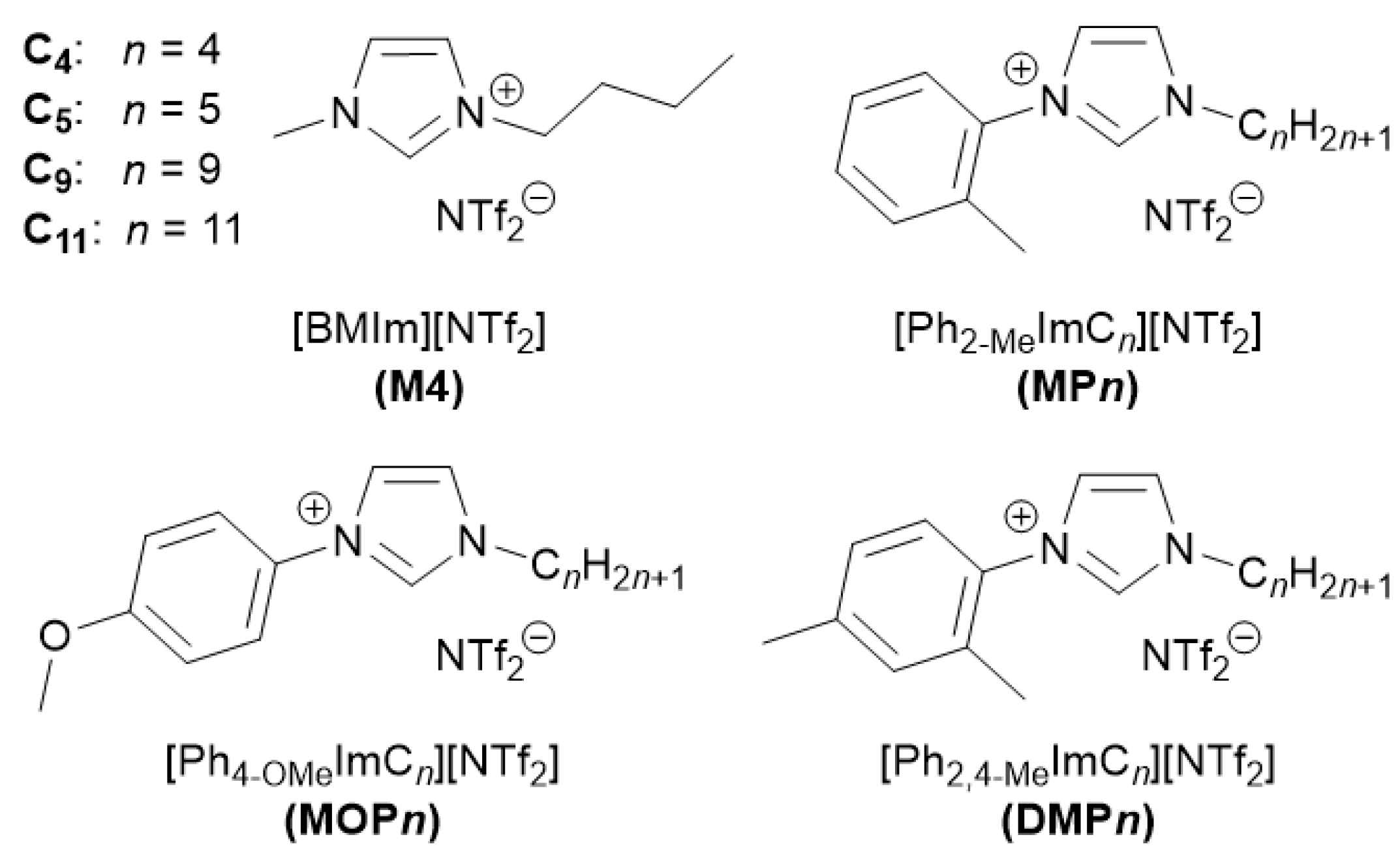
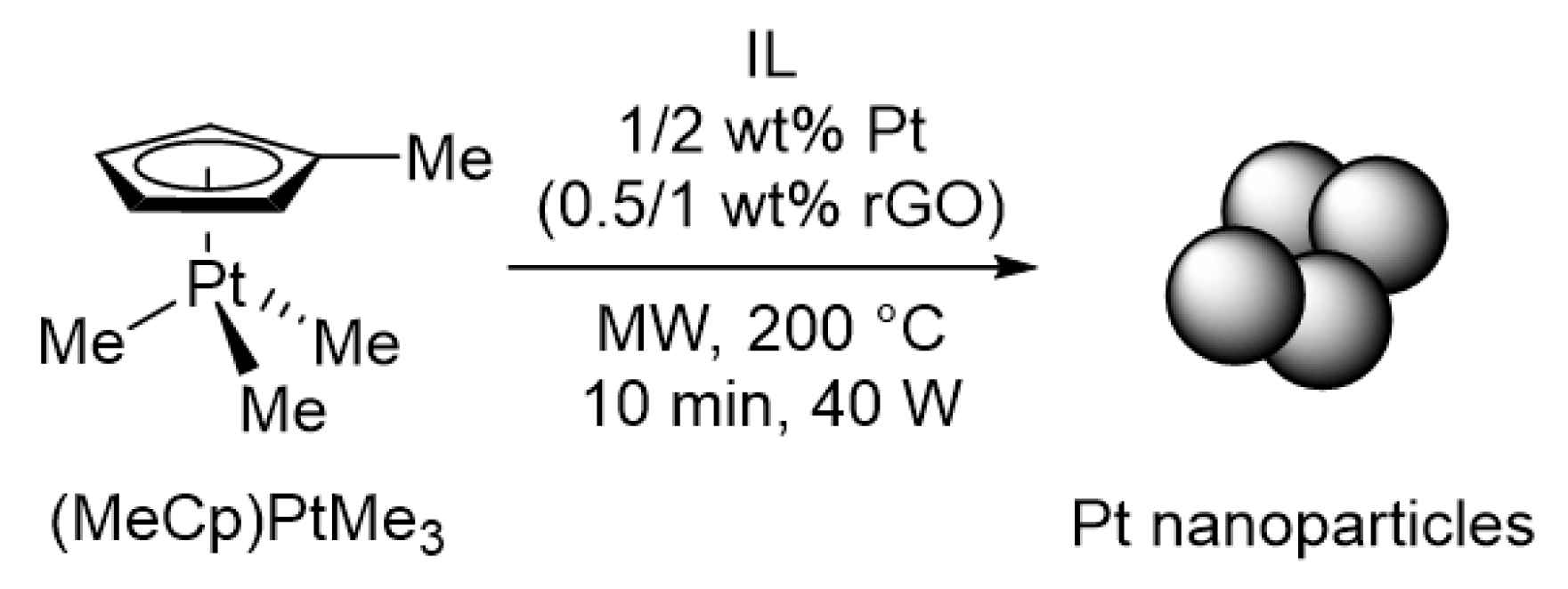
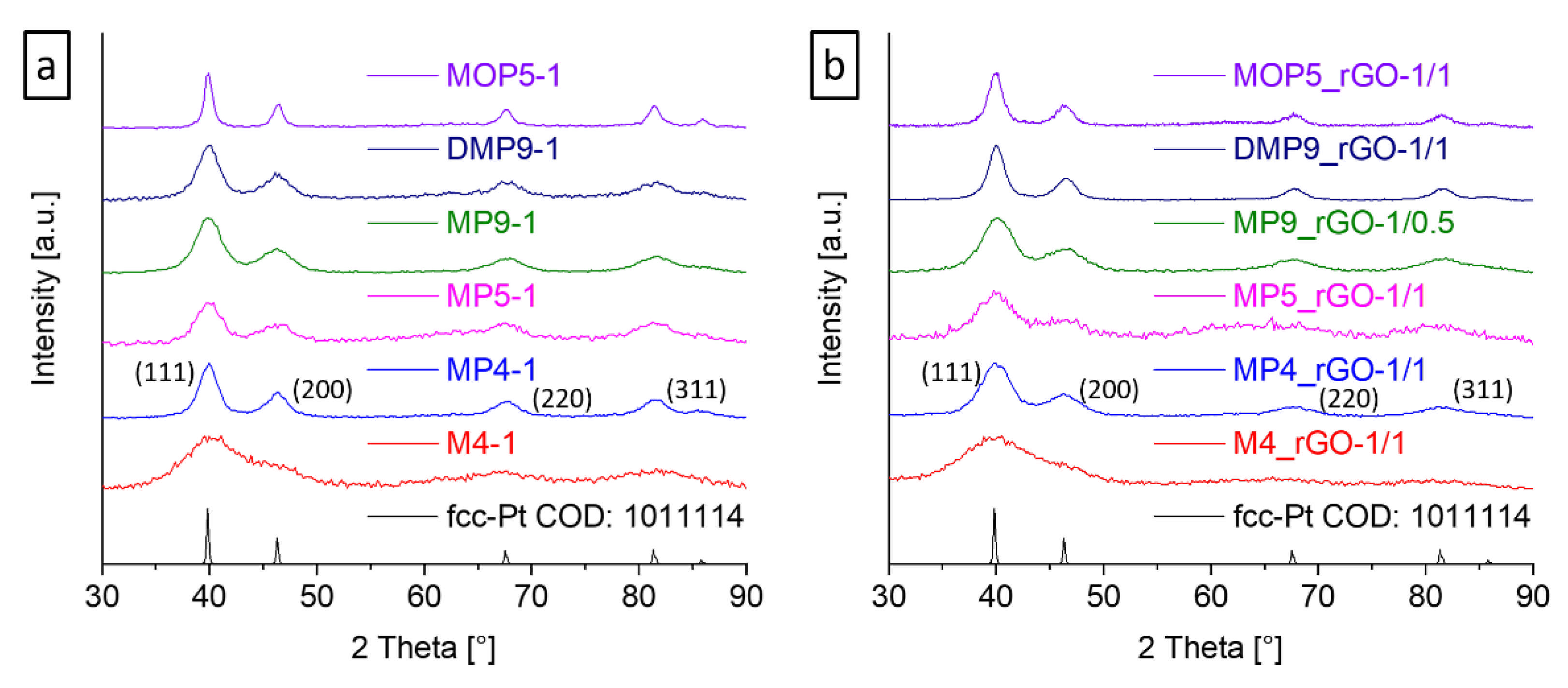
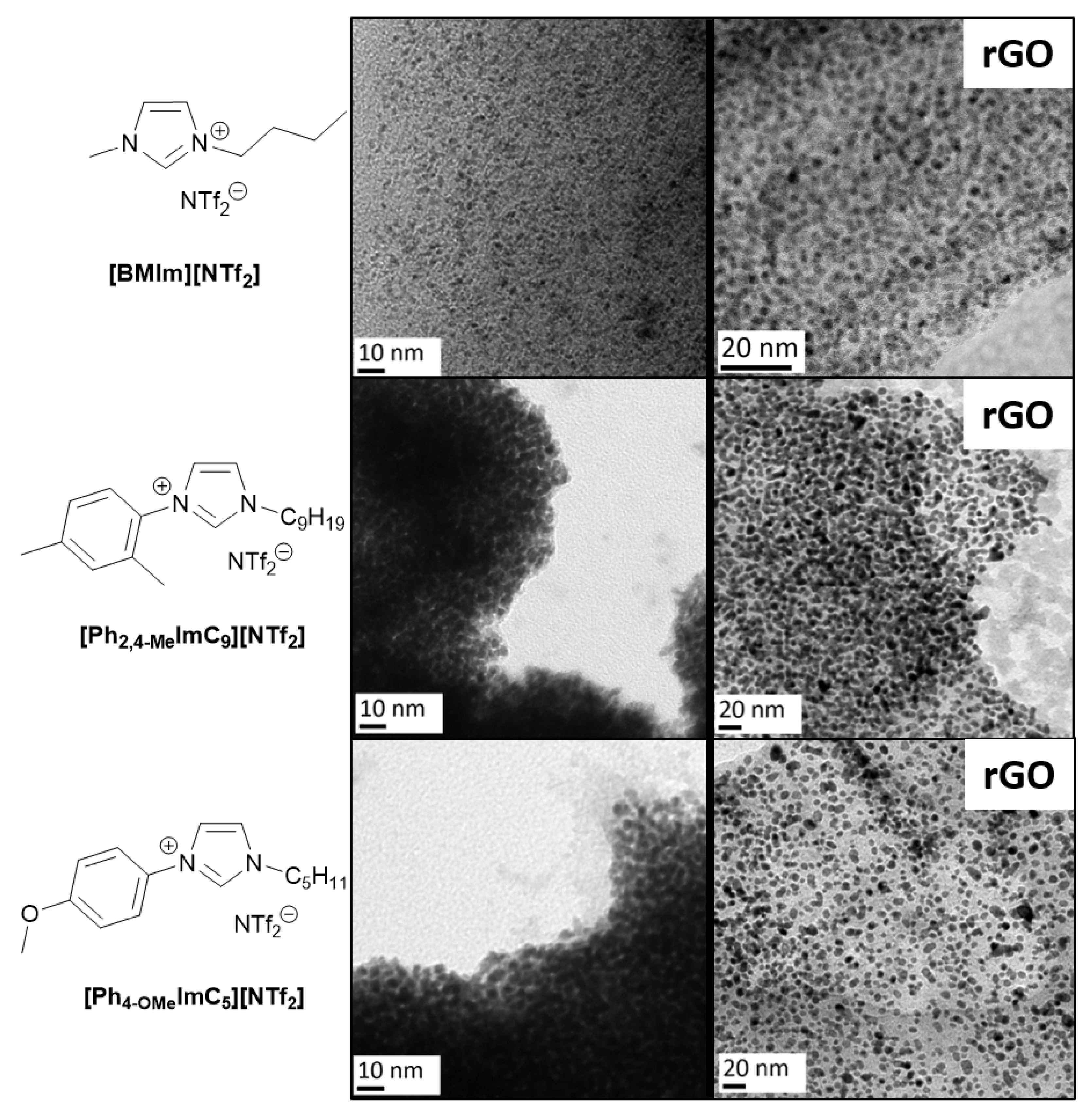
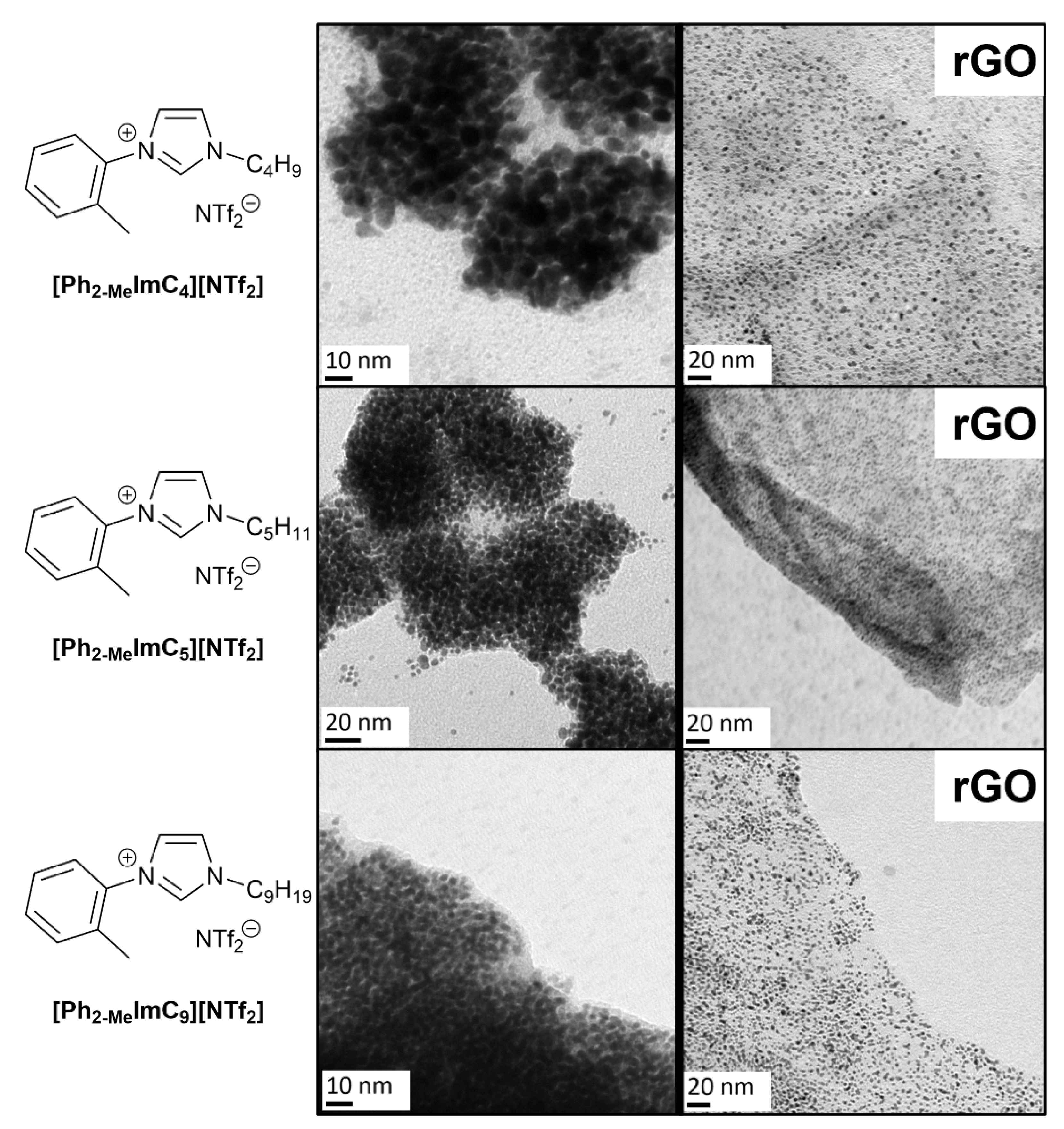
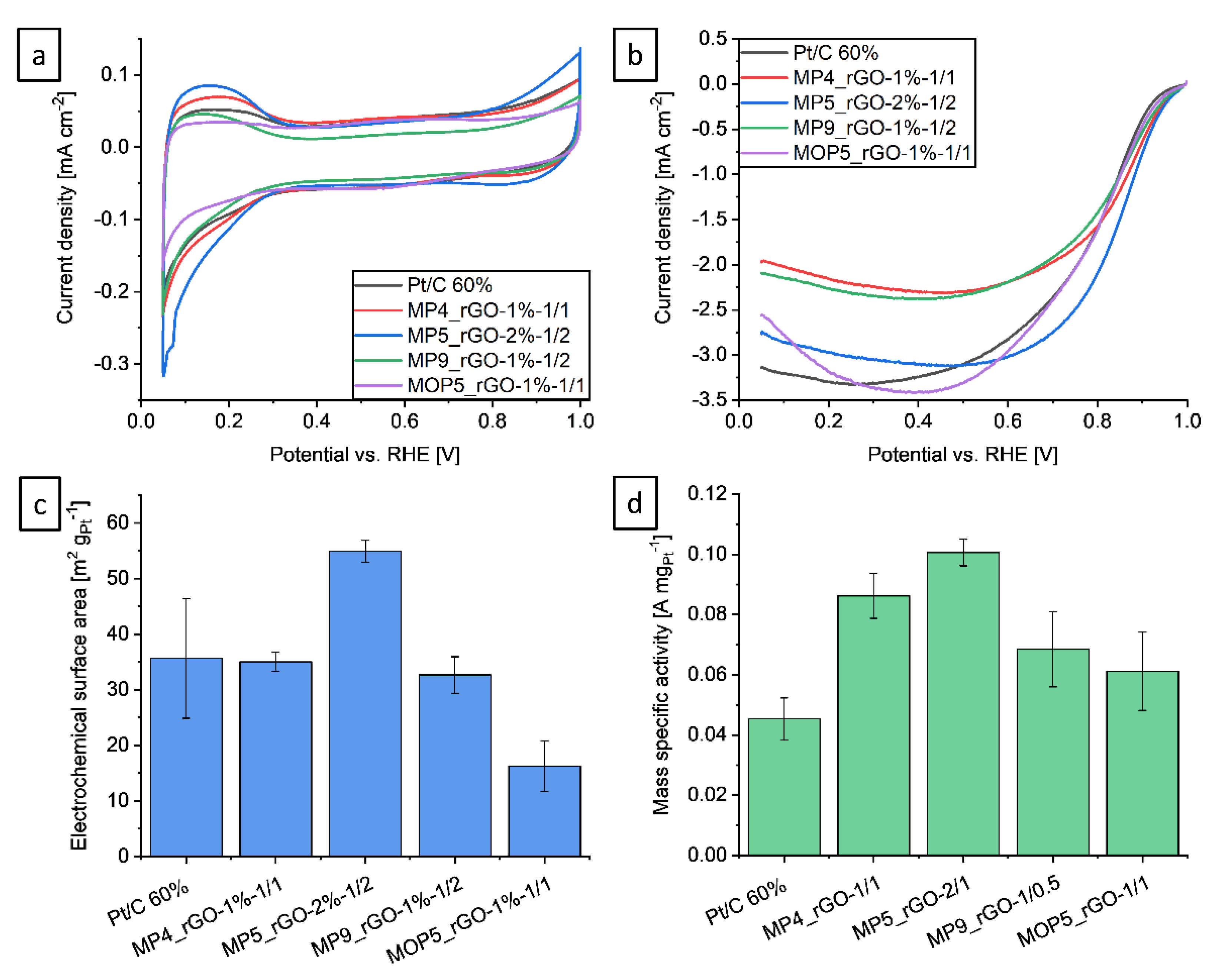

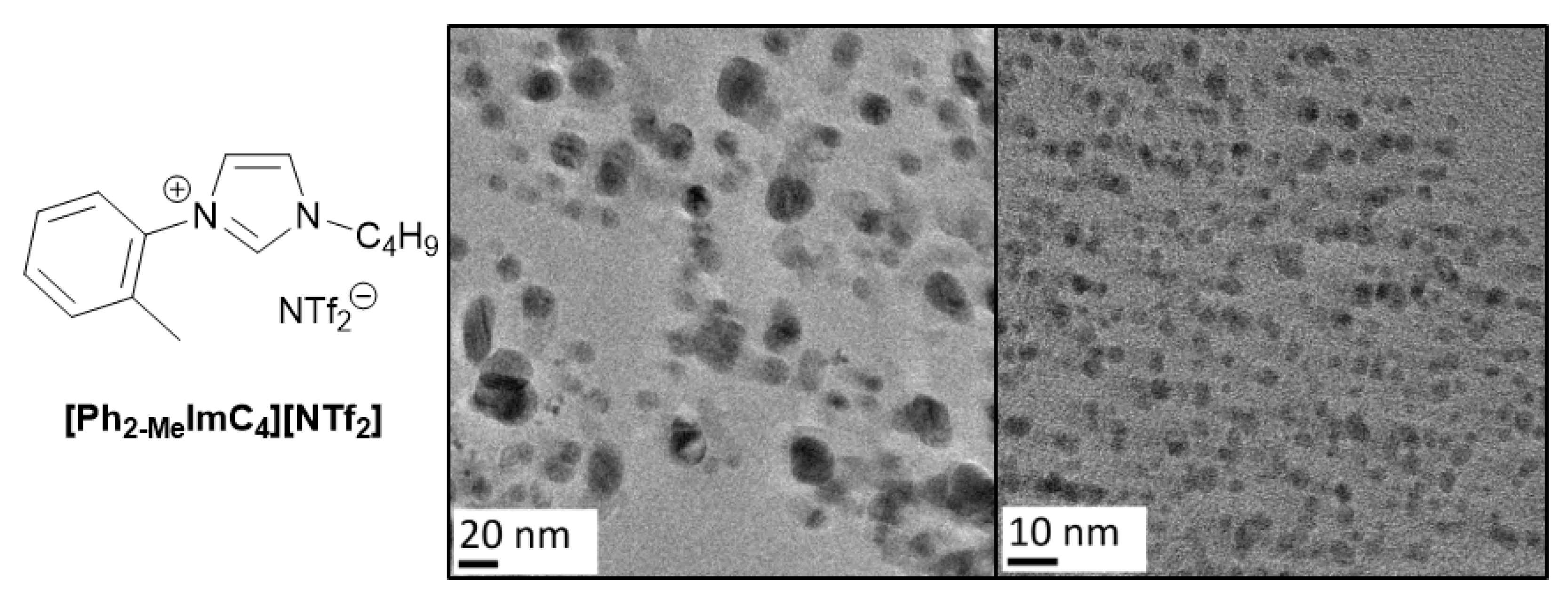
| Sample Name X/Y = wt% Pt/rGO | TAAIL Used | wt% Pt 1 (X/-) | wt% rGO 1 (-/Y) | Average Particle Size 2 [nm] |
|---|---|---|---|---|
| M4-1 | [BMIm][NTf2] | 1 | - | 1 |
| M4_rGO-1/1 | [BMIm][NTf2] | 1 | 1 | 2 ± 1 |
| MP4-1 | [Ph2-MeImC4][NTf2] | 1 | - | 5 ± 1 |
| MP4_rGO-1/1 | [Ph2-MeImC4][NTf2] | 1 | 1 | 3 ± 1 |
| MP5-1 | [Ph2-MeImC5][NTf2] | 1 | - | 4 ± 1 |
| MP5_rGO-2/1 | [Ph2-MeImC5][NTf2] | 2 | 1 | 2 ± 1 |
| MP9-1 | [Ph2-MeImC9][NTf2] | 1 | - | 4 ± 1 |
| MP9_rGO-1/0.5 | [Ph2-MeImC9][NTf2] | 1 | 0.5 | 3 ± 1 |
| DMP9-1 | [Ph2,4-MeImC9][NTf2] | 1 | - | 3 ± 1 |
| DMP9_rGO-1/1 | [Ph2,4-MeImC9][NTf2] | 1 | 1 | 6 ± 1 |
| MOP5-1 | [Ph4-OMeImC5][NTf2] | 1 | - | 2 ± 1 |
| MOP5_rGO-1/1 | [Ph4-OMeImC5][NTf2] | 1 | 1 | 5 ± 1 |
| Sample Name | IL Used | ECSA 1 [m2 gPt−1] | MA 1 [mA mgPt−1] |
|---|---|---|---|
| 60% Pt/C | - | 36 ± 11 | 45 ± 7 |
| MP4_rGO-1/1 | [Ph2-MeImC4][NTf2] | 35 ± 2 | 86 ± 7 |
| MP5_rGO-2/1 | [Ph2-MeImC4][NTf2] | 55 ± 2 | 101 ± 4 |
| MP9_rGO-1/0.5 | [Ph2-MeImC4][NTf2] | 33 ± 3 | 68 ± 12 |
| MOP5_rGO-1/1 | [Ph4-OMeImC4][NTf2] | 16 ± 5 | 61 ± 13 |
| Pt-TMIM-rGO [34] | [C12ImC1][GO] | 56.8 | 346 |
| Pt/rGO (DMF) [35] | - | 28.1 | 26 |
| Pt/rGO (HYD) [35] | - | 18.2 | 7 |
| Pt/rGO [36] | - | 14.0 | 92 |
| Sample | MA [mA mgPt−1] |
|---|---|
| Pt/C 60% activated | 38 |
| Pt/C 60% stability after 5k cycles | 13 |
| MP4_rGO-1/1 activated | 83 |
| MP4_rGO-1/1 stability after 5k cycles | 45 |
Publisher’s Note: MDPI stays neutral with regard to jurisdictional claims in published maps and institutional affiliations. |
© 2022 by the authors. Licensee MDPI, Basel, Switzerland. This article is an open access article distributed under the terms and conditions of the Creative Commons Attribution (CC BY) license (https://creativecommons.org/licenses/by/4.0/).
Share and Cite
Woitassek, D.; Lerch, S.; Jiang, W.; Shviro, M.; Roitsch, S.; Strassner, T.; Janiak, C. The Facile Deposition of Pt Nanoparticles on Reduced Graphite Oxide in Tunable Aryl Alkyl Ionic Liquids for ORR Catalysts. Molecules 2022, 27, 1018. https://doi.org/10.3390/molecules27031018
Woitassek D, Lerch S, Jiang W, Shviro M, Roitsch S, Strassner T, Janiak C. The Facile Deposition of Pt Nanoparticles on Reduced Graphite Oxide in Tunable Aryl Alkyl Ionic Liquids for ORR Catalysts. Molecules. 2022; 27(3):1018. https://doi.org/10.3390/molecules27031018
Chicago/Turabian StyleWoitassek, Dennis, Swantje Lerch, Wulv Jiang, Meital Shviro, Stefan Roitsch, Thomas Strassner, and Christoph Janiak. 2022. "The Facile Deposition of Pt Nanoparticles on Reduced Graphite Oxide in Tunable Aryl Alkyl Ionic Liquids for ORR Catalysts" Molecules 27, no. 3: 1018. https://doi.org/10.3390/molecules27031018







